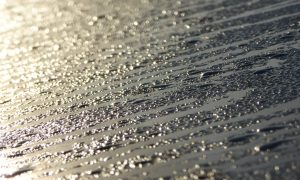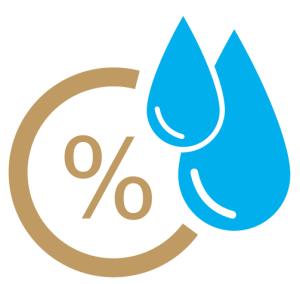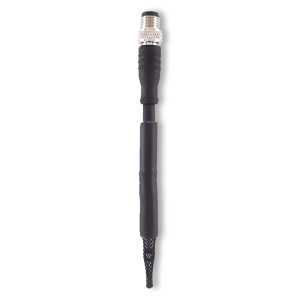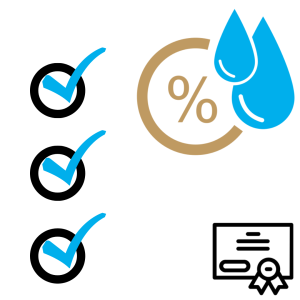Relative Humidity Data: Why Is Temperature Necessary?

When you purchase a precision relative humidity sensor, the temperature is often data returned by the instrument. It is essential to know that relative humidity changes as a function of temperature. Relative humidity is a ratio of water vapour pressure to saturation vapour pressure, both of which vary with temperature and atmospheric pressure. Let's forget about this last parameter for the moment and concentrate on the usefulness of knowing the temperature when we want to measure relative humidity.
Temperature and relative humidity data logger
Some hygrometers measure absolute humidity. However, the density of water molecules in a given volume does not account for the unique behaviour of water, which can be in different phases simultaneously. Indeed, when the air reaches a saturation point in water density in gaseous form, water condenses and becomes liquid. This is why the relative humidity is an essential factor.
Relative humidity

As we said in the introduction, relative humidity (φ) is a rate. It is
φ = 100% PH2O / PSAT(T)
We see here that when the water vapour pressure (PH2O) equals the saturation vapour pressure (PSAT) at a given temperature (T), the relative humidity is 100%. This means that from this point, water will begin to liquefy. This is the saturation point.
In the relative humidity equation, PSAT and PH2O are partial pressures calculated in kilopascals (kPa) or millibar (mbar), for example. The saturation vapour pressure is a constant value at a given temperature. It is a proportion of the atmospheric pressure. For instance, at 0 °C, PSAT is 0.6% of atmospheric pressure, while at 25 °C it is 3% of atmospheric pressure. This implies that between 0 °C and 25 °C, the air can contain five times more water vapour before reaching saturation point. Warning, this is not a linear rule.
Thus, at a given altitude, and therefore at a given atmospheric pressure, the way to influence the relative humidity is to change the temperature to alter PSAT unless the water vapour pressure is adjusted directly.
So why worry about saturation vapour pressure and saturation point? Because your data logger is an electronic device that doesn't do well with condensation, just like many experimental environmental measurement conditions.
Dew point
The dew point is the temperature at which water vapour condenses. Knowing that condensation occurs when the water vapour pressure exceeds the saturation vapour pressure at a given temperature, it is essential to know this temperature. Traditionally, the dew point can be calculated with a psychrometric chart.
Now let's imagine that you want to measure the relative humidity of an enclosed area with a risk of condensation (very high humidity or very low temperature). By knowing the dew point, you know that the temperature of this space cannot go below this point, without condensation. So you need to keep an eye on the temperature of that area, while measuring its relative humidity. You have all the data in hand with an instrument that measures both temperature and relative humidity.
Dracal Technologies' temperature and humidity sensors even calculate the dew point to make your life easier. You can therefore know exactly the temperature not to be exceeded in the precise conditions of your experiment in real-time, preserving your experiments and, at the same time, your instrument.
Electronics
For a detailed article on what to consider when taking a relative humidity measurement, see the following link.
Positioning
When we are interested in measuring instruments that go into the air, the sensor must be kept from being immersed. To avoid damage to the electronic components of your measuring instrument, it is necessary to understand how to position it in a humid environment with a high risk of condensation. The guideline is that water should not remain on the instrument. For example, the TRH320-type probes on Dracal instruments must be mounted vertically and downward so that water will drain off and not come in contact with the sensor.

In addition to this positioning precaution, it is relevant to keep an eye on the dew point to avoid the formation of condensation on an instrument with sensitive electronics. Having said that, if a measuring instrument has been in contact with water and has dried out, it may work again. But you will have lost valuable data during the time it was wet.
Calibration

The calibration of an instrument measuring relative humidity is done in an environmental chamber, where temperature, air pressure and water vapour pressure can be controlled. Since the temperature impacts relative humidity, it is critical to determine at what temperature the relative humidity calibration will be performed. For example, if the measurement uncertainty is ±2%RH between 0%RH and 90%RH at 25°C, it would be wise to calibrate the instrument at 25°C to assess whether the instrument meets the manufacturer's specifications adequately. On the other hand, if the instrument is used at a significantly different temperature, it may be advisable to evaluate its measurement uncertainty at the temperature of use.
Once the calibration temperature is determined, the laboratory can calibrate relative humidity. This time it is helpful to know the relative humidity range where the instrument will be used. According to good practice, three calibration points should be determined: the first at the lower bound of relative humidity, the second at the upper bound and the third in the center of the range.
During calibration, the dew point must not be reached. Therefore, if a temperature and relative humidity sensor is to be calibrated for both parameters, the temperature and humidity change order is essential. Always increase the temperature before increasing the humidity to prevent condensation.
Conclusion
A relative humidity and temperature data logger allows one to check if the environment will reach the dew point, the point of condensation of water vapour in the air. It is understood that this data is beneficial for the instrument's electronics. In the case of storage or transport of humidity-sensitive goods, knowing the temperature together with the relative humidity level also helps to preserve the products or equipment. If the instrument also provides a precise dew point that should not be exceeded at any time, it is even easier to ensure that the environment will not ruin your experiments or equipment.
References
Frederick, J. E. (2008). Principles of Atmospheric Science. États-Unis: Jones and Bartlett Publishers.
Walker, R. and Cordner, A. (2022). Temperature and Relative Humidity Calibration System. [online] Fluke Calibration. Available at: https://us.flukecal.com/literature/articles-and-education/temperature-calibration/papers-articles/temperature-and-relative-h#:~:text=The%20calibration%20procedure%20specifies%20that,within%20the%20specified%20temperature%20range. [Accessed 15 Dec. 2022].